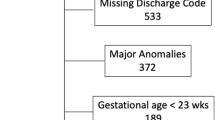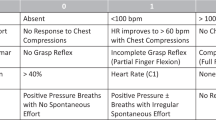Abstract
This study included all newborns with Apgar scores below seven at one minute after birth who were born in 1986 and whose births were notified to the South Australian Perinatal Statistics Collection. Univariate comparisons were made of the demographic, obstetric and pregnancy outcome characteristics of the 301 newborns whose Apgar scores remained below seven at five minutes and the 3165 whose scores recovered to seven or more. The results provide a general risk profile of the 301 newborn infants who perform poorly at birth, as indicated by a low Apgar score at both one and five minutes. Adverse risk factors identified in this study were similar to those for intellectual disability (mental retardation) and cerebral palsy in South Australia. It is suggested that persisting low Apgar scores, when combined with the other risk factors demonstrated in this and previous studies, would provide more reliable prognostic information than would Apgar scores alone.
The study also shows that the majority of infants with low Apgar scores at one minute scored seven or better at five minutes. This demonstrates, that although a low one minute Apgar score has value in identifying newborns in need of immediate attention, it must be supplemented by the five minute score's stronger association with perinatal morbidity.
Similar content being viewed by others
References
AmatoM., GambonR.C. and VonMuraltG. (1986): Accuracy of Apgar score and arterial cord-blood pH in diagnosis of perinatal brain-damage assessed by CK-BB isoenzyme meauserement. - J. Perinat Med. 14: 335–338.
ApgarV. (1953): A proposal for a new method of evaluation of the newborn infant. - Curr Res Anaest Analg. 32: 260–267.
CatlinE.A., CarpenterM.W., BrannB.S., MayfieldS.R., ShaulP.W., GoldsteinM. and OhW. (1986): The Apgar score revisited: Influence of gestational age. - J Pediatr. 109: 865–868.
ChanA., MacharperT. and ListerJ. (1988): Pregnancy Outcome in South Australia 1986. Adelaide. Pregnancy Outcome Unit: Epidemiology Branch, South Australina Health Commission.
DijxhoornM.J., VisserG.H.A., FidlerV.J., TouwenB.C.L. and HuisjesH.J. (1986): Apgar score, meconiu,m and acidaemia at birth in relation to neonatal neurological morbidity in term infants. - Br J Obstet Gynaecol. 93: 217–222.
DrageJ.S. and BerendesH. (1986): Apgar scores and outcome of the newborn. - Pediatr Clin North Am. 13: 635–643.
GreenoughA., LagercrantzH., PoolJ. and DahlinI. (1987): Plasma catecholamine levels in preterm infants: Effect of birth asphyxia and Apgar score. -Acta Paediatr Scand. 76: 54–59.
HagbergB., HagbergG., LewerthA. and LindbergU. (1981): Mild mental retardation in Swedish school children. - II Etiologic and pathogenetic aspects. Acta Peadiatr Scand. 70: 445–452.
JonasO., RoderD., EstermanA., MacharperT. and ChanA. (1989): Pregnancy and birth risk factors for intellectual disability in South Australia. - Eur. J. Epidemiol. 5: 322–327.
JonasO., SternL.M. and MacharperT. (1989): A South Australian study of pregnancy and birth risk factors associated with cerebral palsy. - Int J Rehal Research 12: 159–166.
NelsonK.B. and BromanS.H. (1977): Perinatal risk factors in children with serious motor and mental handicaps. - Ann Neurol. 2: 371–377.
NelsonK.B. and EllenbergJ.H. (1981): Apgar scores as predictors of chronic neurologic disability. -Pediatrics. 68: 36–44.
RantakallioP. and Von WendtI. (1985): Risk factors for mental retardation. - Arch Dis Child. 60: 946–952.
SaitoT., FujiiT. and TangoT. (1983): Prediction of the development of cerebral palsy from perinatal risk factors. - Brain Dev. 5: 1–8.
SykesG.S., MolloyP.M., JonhsonP., GuW., AshworthF., StirratG.M. and TurnbullA.C. (1982): Do Apgar scores indicate asphyxia? - Lancet 1: 494–496.
Author information
Authors and Affiliations
Rights and permissions
About this article
Cite this article
Jonas, O., Chan, A., Macharper, T. et al. Pregnancy and perinatal factors associated with persistently low apgar scores: An analysis of the birth records of infants born in South Australia. Eur J Epidemiol 6, 136–141 (1990). https://doi.org/10.1007/BF00145785
Issue Date:
DOI: https://doi.org/10.1007/BF00145785




